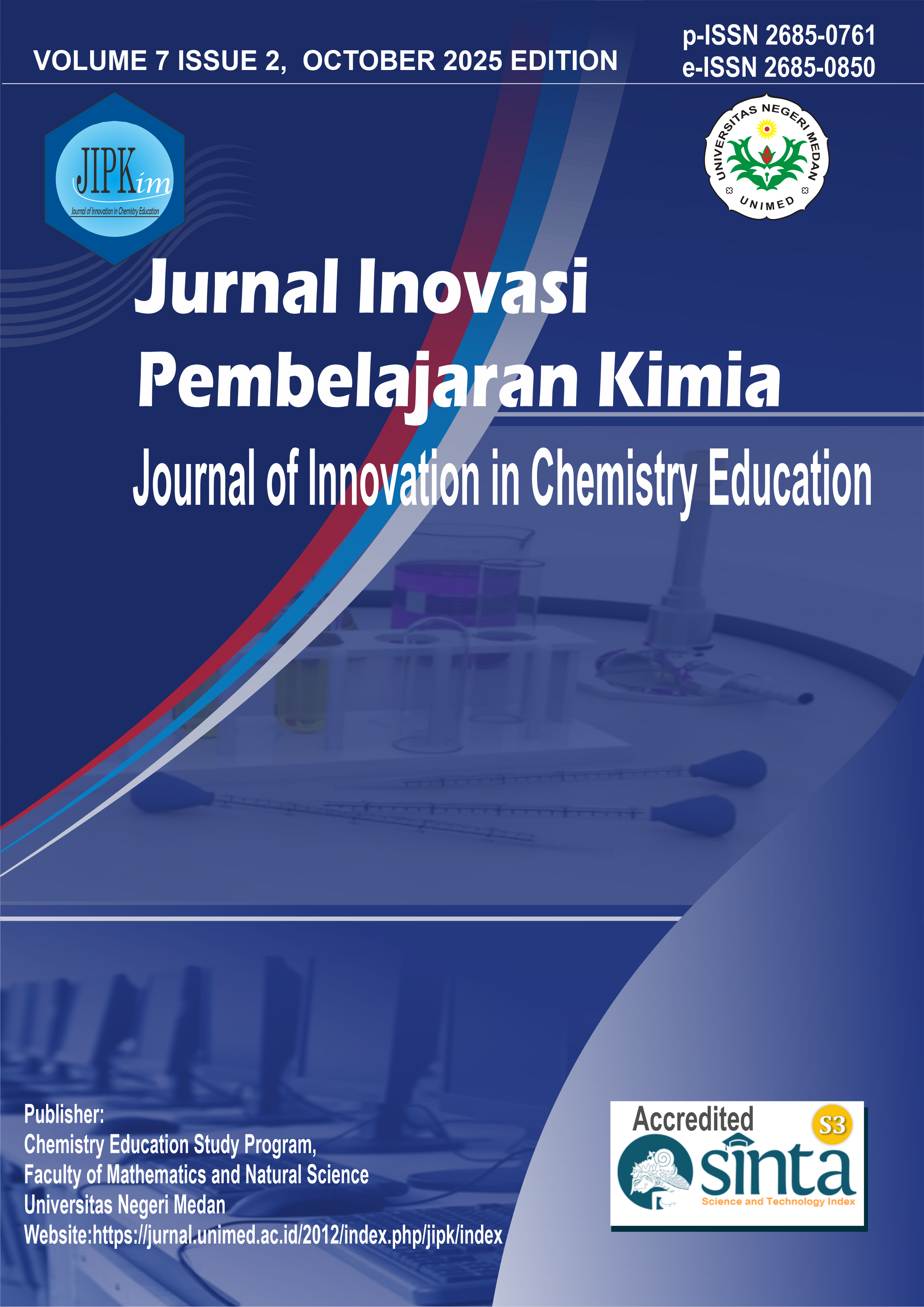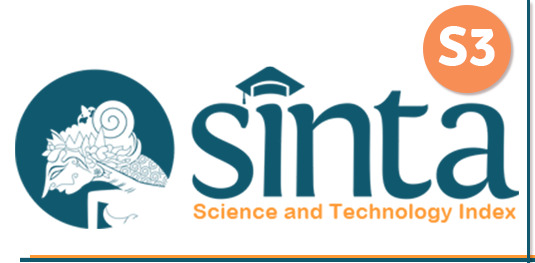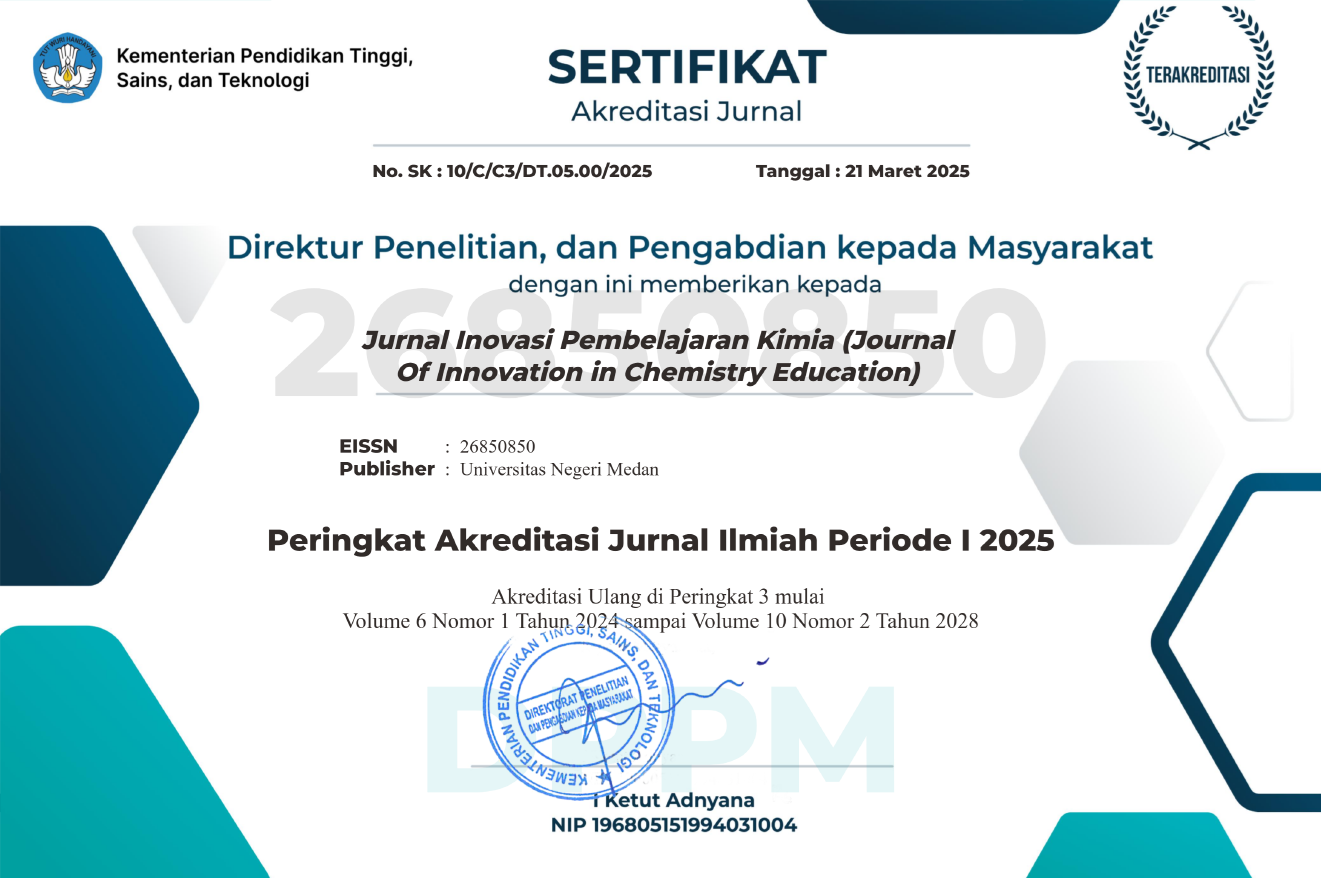The Relationship Between Interpersonal Communication Skills and Student Problem-Solving Ability in Chemistry Learning
Keywords:
interpersonal communication, problem-solving, chemistry learningAbstract
Problem-solving in chemistry is a multifaceted process influenced by both cognitive and social factors, including students’ interpersonal communication skills. This study aimed to examine the relationship between students’ interpersonal communication skills and their problem-solving ability in chemistry learning. A quantitative correlational design was employed, involving 157 eleventh-grade students from SMA Labschool Jakarta, Cibubur, and Cirendeu. Students’ problem-solving ability was measured using a multiple-choice multiple-answer (MCMA) test, while their interpersonal communication skills were assessed using the Interpersonal Communication Competence Scale (ICCS). The results showed a significant but weak positive correlation (r = 0.294) between the two variables, indicating that students with stronger interpersonal communication skills tend to perform better in solving chemistry problems. Although the contribution of interpersonal communication was relatively small, it suggests that social interaction and communicative engagement play a meaningful role in supporting cognitive performance. These findings underscore the importance of fostering interpersonal communication within chemistry education to enhance students’ problem-solving outcomes.References
Adler, R. B., & Proctur II, R. F. (2011). Looking Out, Looking in (13th ed.). Cengage Learning.
Akben, N. (2020). Effects of the Problem-Posing Approach on Students’ Problem Solving Skills and Metacognitive Awareness in Science Education. Research in Science Education, 50(3), 1143–1165. https://doi.org/10.1007/s11165-018-9726-7
Al-thani, N. J., Siby, N., Saad, A., Bhadra, J., Qahtani, N., Sellami, A., & Ahmad, Z. (2025). Meta-analysis of chemistry-based interdisciplinary informal research experience program for high school students. Evaluation and Program Planning, 108. https://doi.org/10.1016/j.evalprogplan.2024.102517
Ariawan, R., & Nufus, H. (2017). Hubungan Kemampuan Pemecahan Masalah Matematis dengan kemampuan Komunikasi Matematis Siswa. Jurnal THEOREMS (The Original Research of Mathematics), 1(2), 82–91.
Azizah, U., Nasrudin, H., & Mitarlis. (2019). Metacognitive Skills: A Solution in Chemistry Problem Solving. Journal of Physics: Conference Series, 1417(1). https://doi.org/10.1088/1742-6596/1417/1/012084
Bienvenu, M. J., & Stewart, D. W. (1976). Dimensions of interpersonal communication. Journal of Psychology: Interdisciplinary and Applied, 93(1), 105–111. https://doi.org/10.1080/00223980.1976.9921380
Bodner, G. M., & Herron, J. D. (2003). Problem-Solving in Chemistry. In J. K. Gilbert, O. De Jong, R. Justi, D. F. Treagust, & J. H. Van Driel (Eds.), Chemical Education: Towards Research-based Practice (pp. 235–266). Springer Netherlands. https://doi.org/10.1007/0-306-47977-X_11
Bransford, J. D., & Stein, B. S. (1993). The IDEAL Problem Solver: A Guide for Improving Thinking, Learning and Creativity. W. H. Freeman and Company.
Chen, L., Inoue, K., Goda, Y., Okubo, F., Taniguchi, Y., Oi, M., Konomi, S., Ogata, H., & Yamada, M. (2020). Exploring Factors that Influence Collaborative Problem Solving Awareness in Science Education. Technology, Knowledge and Learning, 25(2), 337–366. https://doi.org/10.1007/s10758-020-09436-8
Crawford, G. L., Kloepper, K. D., Meyers, J. J., & Singiser, R. H. (2019). Communicating Chemistry: An Introduction. In ACS Symposium Series (Vol. 1327, pp. 1–15). American Chemical Society. https://doi.org/10.1021/bk-2019-1327.ch001
de la Fuente, A., Cardeñoso, O., Chang, E. C., Lucas, A. G., Li, M., & Chang, O. D. (2023). The role of problem-solving ability, beyond academic motivation, in college students’ psychological adjustment. Current Psychology, 42(21), 17888–17897. https://doi.org/10.1007/s12144-022-02945-y
DeVito, J. A. . (2022). The interpersonal communication book (16th ed.). Pearson Education.
Dostál, J. (2015). Theory of Problem Solving. Procedia - Social and Behavioral Sciences, 174, 2798–2805. https://doi.org/10.1016/j.sbspro.2015.01.970
Ennis, R. H. (1985). A Logical Basis for Measuring Critical Thinking Skills. Educational Leadership. Educational Leadership, 43(2), 44–48.
Febriyanti, A., & Ananda Ismail, I. (2022). The Role of Interpersonal Communication Between Teachers and Students to Improve the Success of the Learning Process. International Journal of Progressive Sciences and Technologies (IJPSAT, 30(2), 37–41. https://doi.org/10.52155/ijpsat.v30.2.3974
Gabel, D. (1999). Improving Teaching and Learning through Chemistry Education Research: A Look to the Future*. In Research: Science and Education 548 Journal of Chemical Education • (Vol. 76, Issue 4).
Gamble, T. K., & Gamble, M. W. (2014). Interpersonal Communication: Building Connections Together. SAGE Publications, Inc.
Govindaraju, V., & Seruji, Z. (2022). Interpersonal Communication and Relationship: A Conceptual Review between Educators and Undergraduate Students. Multicultural Education, 8(6), 30–37. https://doi.org/10.5281/zenodo.6618219
Güner, P., & Erbay, H. N. (2021). Metacognitive Skills and Problem-Solving. International Journal of Research in Education and Science, 7(3), 715–734. https://doi.org/10.46328/ijres.1594
Gurat, M. G. (2018). Mathematical problem-solving strategies among student teachers. Journal on Efficiency and Responsibility in Education and Science, 11(3), 53–64. https://doi.org/10.7160/eriesj.2018.110302
Han, J.-H., Ahn, E., & Hwang, J.-M. (2019). Effects of Critical Thinking and Communication Skills on the Problem-Solving Ability of Dental Hygiene Students. Journal of Dental Hygiene Science, 19(1), 31–38. https://doi.org/10.17135/jdhs.2019.19.1.31
Huang, X., & Lajoie, S. P. (2023). Social emotional interaction in collaborative learning: Why it matters and how can we measure it? In Social Sciences and Humanities Open (Vol. 7, Issue 1). Elsevier Ltd. https://doi.org/10.1016/j.ssaho.2023.100447
Kaya, S. (2024). One intervention, several benefits: Deliberate computer-assisted argument mapping practices in an online teacher education course. Journal of Computer Assisted Learning, 40(6), 3230–3248. https://doi.org/10.1111/jcal.13067
Krulik, Stephen., & Rudnick, J. A. . (1988). Problem solving : a handbook for elementary school teachers. Allyn and Bacon.
Kurniawati, Y., Mayshinta, I., & Yenti, E. (2023). Identifikasi Kesulitan Materi Kimia Bagi Siswa SMA: Kajian Literatur. 23–27. https://doi.org/10.36378/prosidinguniks.v0i0
Lazarus, R. S., & Folkman, S. (1987). Transactional theory and research on emotions and coping. In European Journal of Personality (Vol. 1).
Ma, X., Yin, Z., & and Luo, X. (2023). Students’ and teachers’ critical thinking in science education: are they related to each other and with physics achievement? Research in Science & Technological Education, 41(2), 734–758. https://doi.org/10.1080/02635143.2021.1944078
Makiyah, Y. S., Mahmudah, I. R., Sulistyaningsih, D., & Susanti, E. (2021). Hubungan Keterampilan Komunikasi Abad 21 dan Keterampilan Pemecahan Masalah Mahasiswa Pendidikan Fisika. Journal of Teaching and Learning Physics, 6(1), 1–10. https://doi.org/10.15575/jotalp.v6i1.9412
Malangtupthong, P., Nurittamont, W., & Phayaphrom, B. (2022). Factors Influencing Mathematical Problem-Solving Competency: A Case Study On High School Student. Article in PSAKU International Journal of Interdisciplinary Research, 11(2), 1–18. https://doi.org/10.14456/psakuijir.2022.6
Malinda Wilson, L. G. (2015). The Importance of Critical Thinking, Verbal Reasoning and Mathematics in Teaching Chemistry in the 21st Century. Modern Chemistry & Applications, 03(03). https://doi.org/10.4172/2329-6798.1000e121
Martin, M., & Rubin, R. (1994). Development of a Measure of Interpersonal Communication Competence. Communication Research Reports, 11(1), 33–44. https://doi.org/10.1080/08824099409359938
Minarsi, M., Nirwana, H., & Yarmis, Y. (2018). Contribution of the interpersonal communication toward problem solving strategies of high school students. 80–85. https://doi.org/10.29210/2018112
National Research Council. (2013). Framework for K-12 Science Education: Practices, Crosscutting Concepts, and Core Ideas. The National Academies Press. https://doi.org/https://doi.org/10.17226/13165
Ocak, G., Dogruel, A. B., & Tepe, M. E. (2022). An Analysis of the Relationship between Problem Solving Skills and Scientific Attitudes of Secondary School Students. International Journal of Contemporary Educational Research, 8(1), 72–83. https://doi.org/10.33200/ijcer.780710
OECD. (2004). The PISA 2003 Assesment Framework: Mathematics, Reading, Science and Problem Solving Knowledge and Skills. https://doi.org/https://doi.org/10.1787/9789264101739-en.
OECD. (2023). PISA 2022 Results (Volume I): The State of Learning and Equity in Education. https://oecdch.art/a40de1dbaf/C108.
OECD. (2024). PISA 2022 Results Volume III: Creative Minds, Creative Schools. https://doi.org/https://doi.org/10.1787/765ee8c2-en.
Paul, R., & Elder, L. (2008). Paul, R., & Elder, L. (2008). The Miniature Guide to Critical Thinking: Concepts and Tools. Foundation for Critical Thinking. www.criticalthinking.org
Polya, G. (1973). How to solve it: A New Aspect of Mathematical Method (2nd ed.). Princeton University Press.
PRAKONG, S. (2024). The Role of Critical Thinking in Enhancing Students’ Problem-Solving Abilities in Higher Education. Journal of Education, Humanities, and Social Research, 1(1), 10–16. https://doi.org/10.70088/scx8x622
Safitri, N. C., Nursaadah, E., & Wijayanti, I. E. (2019). Analisis Multipel Representasi Kimia Siswa pada Konsep Laju Reaksi. EduChemia (Jurnal Kimia Dan Pendidikan), 4(1), 1. https://doi.org/10.30870/educhemia.v4i1.5023
Scherer, R., Meßinger-Koppelt, J., & Tiemann, R. (2014). Developing a computer-based assessment of complex problem solving in Chemistry. International Journal of STEM Education, 1(1). https://doi.org/10.1186/2196-7822-1-2
Sevian, H., & Talanquer, V. (2014). Rethinking chemistry: A learning progression on chemical thinking. In Chemistry Education Research and Practice (Vol. 15, Issue 1, pp. 10–23). https://doi.org/10.1039/c3rp00111c
Turiman, P., Omar, J., Daud, A. M., & Osman, K. (2012). Fostering the 21st Century Skills through Scientific Literacy and Science Process Skills. Procedia - Social and Behavioral Sciences, 59, 110–116. https://doi.org/10.1016/j.sbspro.2012.09.253
Venable, G. T., Shepherd, B. A., Loftis, C. M., McClatchy, S. G., Roberts, M. L., Fillinger, M. E., Tansey, J. B., & Klimo, P. (2016). Bradford’s law: Identification of the core journals for neurosurgery and its subspecialties. In Journal of Neurosurgery (Vol. 124, Issue 2, pp. 569–579). American Association of Neurological Surgeons. https://doi.org/10.3171/2015.3.JNS15149
Wood, J. T. (2010). Interpersonal Communication: Everyday Encounters. Cengage Learning.
World Economic Forum. (2025). The Future of Jobs Report 2025. https://www.weforum.org/publications/the-future-of-jobs-report-2025/
Yuriev, E., Naidu, S., Schembri, L. S., & Short, J. L. (2017). Scaffolding the development of problem-solving skills in chemistry: Guiding novice students out of dead ends and false starts. Chemistry Education Research and Practice, 18(3), 486–504. https://doi.org/10.1039/c7rp00009j













